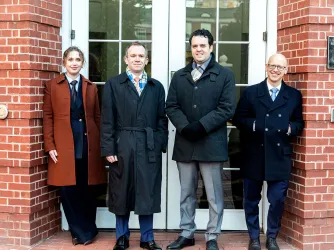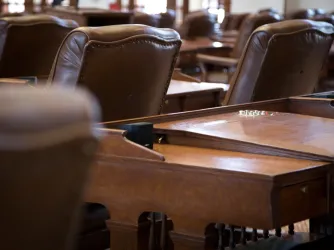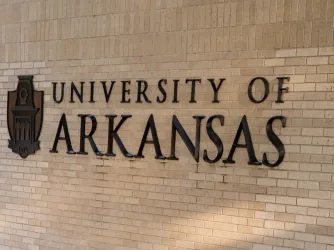Table of Contents
Seven early responses to oral arguments in web designer same-sex marriage case — First Amendment News 358

The case is 303 Creative LLC v. Elenis, and the issue raised is whether applying a public-accommodation law to compel an artist to speak or stay silent violates the free speech clause of the First Amendment. Earlier this week the U.S. Supreme Court heard oral arguments in the case (transcript here).
Kristen Waggoner argued the case on behalf of the petitioners, and Colorado Solicitor General Eric R. Olson argued the case on behalf of respondents. Brian H. Fletcher, a deputy solicitor general in the Department of Justice, argued on behalf of the United States as amicus curiae supporting the respondents.
#1 — Steven Shiffrin: “[C]ase is bereft of needed facts”

The web designer cannot show in this case that she will be forced to produce content with which she disagrees. On that point, the case is bereft of needed facts. To be sure, there are circumstances where a person is such an important part of the wedding that human dignity would be violated by compulsory participation even if the person is not forced to utter content with which the person disagrees.
Consider a minister or a singer forced to say prayers or sing songs at a wedding even if the prayers or songs do not have content that is opposed by the minister or singer. Surely, a web designer is not an important part of a wedding.
#2 — David Cole: Court did not frame the question correctly

Can an artist be compelled to create a website for an event she does not condone? That’s the question the Supreme Court has said it will take up . . . when it hears oral arguments in 303 Creative v. Elenis. The answer would seem to be obviously “no.”
But that’s the wrong question. The right question is whether someone who chooses to open a business to the public should have the right to turn away gay customers simply because the service she would provide them is “expressive” or “artistic.” Should an architecture firm that believes Black families don’t deserve fancy homes be permitted to turn away Black clients because its work is “expressive”? Can a florist shop whose owner objects to Christianity refuse to serve Christians? The answer to these questions would seem to be, just as obviously, “no.”
- David Cole, “The Supreme Court Is About to Ask the Wrong Question About the First Amendment,” The New York Times (Dec. 5)
#3 — Michael McConnell: What about civil rights protections and suppression of speech?

One thing is clear from the argument: 303 Creative is not about whether protections for LGBT people will be dampened. The decision will apply across the board. The question is whether civil rights protections properly include the suppression of speech that disagrees with legal norms, or compels speech that celebrates those norms. Alternatively: do artists (including web designers) have the freedom to depict what subjects they wish, and how—even if they take money for doing it, and even if their perspective is hurtful (to some people)?
[ . . . ]
No, the issue debated in 303 Creative is not whether protections for LGBTQ people will be curtailed. It is much smaller, and much larger, than that. Smaller: because all actual protections against discrimination in public accommodations will remain in place. No one has the right to compel other people to use their expressive talents to celebrate their status; civil rights laws have never required this for any protected class and the Colorado law should not have been interpreted to do so. And larger: because the case is really about artistic freedom and the right of people engaged in expressive professions to determine their subjects and perspective. If the State of Colorado can require this web designer to create a website celebrating a message contrary to her sincere beliefs, there will be no end of it.
- Eugene Volokh, “Prof. Michael McConnell (Stanford) on 303 Creative (the Web Site Designer / Same-Sex Wedding Case),” The Volokh Conspiracy (Dec. 6)
Related: “A new Supreme Court case may dampen protections for LGBT people,” The Economist (Dec. 5)
#4 — Mark Joseph Stern: No compelled speech

303 Creative is not, in fact, that case. Why? Because Colorado law does not compel Smith to create a wedding website for a same-sex couple, or for anyone else. It only insists that once Smith has designed a wedding website, she must allow same-sex couples to purchase that product. In essence, Colorado says she must sell her website template to all customers, regardless of their identity. She need not create a new template or “speak” in support of any marriage. At most, if she makes a wedding website for Henry and Fiona, she must sell the same template to Henry and Frank. As Colorado Solicitor General Eric Olson acknowledged, she could even make a template that (for some reason) condemned same-sex marriage. This speech is permitted. Colorado targets only the conduct of refusing to sell that product to gay people.
- Mark Joseph Stern, “The Easy-to-Miss Twist That Makes the Supreme Court’s New Gay Rights Case So Strange,” Slate (Dec. 5)
#5 — Mark Joseph Stern: The future of employer-employee relations
Gorsuch seems to believe that when the state orders an employer to conduct [certain types of employee] training, it has violated the First Amendment. The consequences of this theory would be vast and severe. As I wrote in 2018, a hotel supervisor who thinks interracial relationships are sinful could refuse to tell employees to let mixed-race couples book rooms. A restaurant manager with spiritual objections to interfaith marriage could decline to train employees in their duty to serve customers without regard to religion. Gorsuch’s theory would extend beyond public accommodations into the realm of employment. Right now, a supervisor can be held liable when they do not stop employees from discriminating. Under Gorsuch’s theory, supervisors could refuse to educate their workers about illegal discriminatory behaviors by claiming that such instruction would violate their beliefs. Imagine, for example, a manager who says he holds the religious view that women belong in the home. He could claim a First Amendment right not to tell workers they must treat their female colleagues equally, citing his faith-based convictions about women’s inferiority.
- Mark Joseph Stern, “The Frightening Implications of Gorsuch’s Angry Questions About State ‘Reeducation,’” Slate (Dec. 6)
Related: Ilya Shapiro, Eugene Volokh, Theodore H. Frank, and Dale Carpenter, “The First Amendment, antidiscrimination laws and unique services” Amicus brief (Oct. 27, 2021)
Unfortunately, both federal and state courts have provided uncertain and conflicting guidance on how to apply this Court’s decisions in cases like Smith’s. The Eighth Circuit faithfully applied Hurley, recognizing that the First Amendment limits anti-discrimination laws. See, e.g., Telescope Media, 936 F.3d at 758–60. Other courts have determined the asserted expressive components of a business’s product do not warrant First Amendment protection. See, e.g., Elane Photography, LLC v. Willock, 309 P.3d 53, 63–64 (N.M. 2013). And now the Tenth Circuit has ruled that, even if a law forces an individual to promote a message to which he or she objects, it can be enforced so long as courts can characterize the product or service denied as unique.
This Court has the chance to clarify how the First Amendment applies to public accommodation laws for expressive goods and services. This Court can reaffirm Hurley, remind the lower courts that the First Amendment’s protections are subject to state anti-discrimination law, and clarify the circumstances in which heightened judicial scrutiny may be met.
#6 — Steven D. Schwinn: Can the Court avoid landmines?

As a free-speech case, 303 Creative will force the Court to navigate some distinctive landmines with roundly discredited historical antecedents. For example, Smith’s proposed statement echoes and amplifies earlier statements by many commercial establishments that they will not serve individuals of a particular race, ethnicity, or nationality. Similarly, Smith’s proposed exception from anti-discrimination laws echoes and amplifies earlier statements by many commercial establishments and individuals that they have a free-speech or free-association right to discriminate, anti-discrimination laws notwithstanding.
Smith tries to provide the Court with a roadmap through these landmines. She does this by focusing narrowly on her work as an “artist” with a creative message (and not just an ordinary business), who proposes to work in a particular area, weddings, where views can be strong and mixed. It’s not at all clear that Smith’s roadmap actually dodges the landmines, though. As the state contends, her efforts to narrow her case and distinguish her work may simply create confusion and uncertainty as to the application of anti-discrimination law.
This could mean that any ruling for Smith would open the door wide for other exemptions from anti-discrimination laws. For example, even a narrow ruling for Smith could invite other individuals and businesses to cast themselves as “artists,” or define their work as serving a particular market that is inextricably tied up with speech. (It’s easy to see how any variety of individuals and businesses could lodge these claims.) It could also invite individuals and businesses to seek exemptions from anti-discrimination laws for those discredited historical practices, mentioned above. Given the nature of this case (in contrast to Masterpiece, where there was a record of enforcement), there may be no obvious way for the Court to rule for Smith while not effectively drilling a tunnel through anti-discrimination laws.
One final observation. The Court’s jurisprudence in this area—testing First Amendment rights against anti-discrimination laws—seems to treat laws protecting against LGBTQ+ discrimination less favorably than it treats laws protecting against other kinds of discrimination. The Court doesn’t specifically acknowledge this, however, much less provide a principled reason for the difference.
If the Court rules for Smith, it may have to say that quiet part out loud. In other words, it may have to explain why free speech protects Smith’s statements that she won’t create websites for same-sex weddings, even if free speech would not protect her statements that she won’t create websites for, say, Black weddings. Any attempt to explain this difference could prove exceedingly embarrassing (and uncomfortably revealing) for the Court. Yet a ruling for Smith without this explanation will simply invite the next inevitable case, testing whether free speech protects a business’s announcement that they will not serve Black people.
- Steven D. Schwinn, “Supreme Court to Test Free Speech Against Anti-Discrimination,” Constitutional Law Prof Blog (Dec. 2)
#7 — Jessica Gresko and Mark Sherman: Might this help explain why the Court did not review the free exercise claim?

During arguments at the Court Monday, Justice Brett Kavanaugh asked Waggoner, Smith’s lawyer, about what would happen if the Court sided with her. And he pointed to a section of her written submission to the high court where she said Smith as an artist is different from other business people including hairstylists, landscapers, plumbers, caterers, tailors, jewelers and restaurants that do not generally communicate a message through their work.
If she wins, Waggoner said, she might bring similar cases on behalf of others whose work involves creative inspiration. But, she said, “I won’t be coming back with a caterer.”
- Jessica Gresko and Mark Sherman, “Justices spar in latest clash of religion and gay rights,” Associated Press (Dec. 6)
New study reveals hate speech on the rise on Twitter
- Sheera Frenkel and Kate Conger, “Hate Speech’s Rise on Twitter Is Unprecedented, Researchers Find,” The New York Times (Dec. 2)
Before Elon Musk bought Twitter, slurs against Black Americans showed up on the social media service an average of 1,282 times a day. After the billionaire became Twitter’s owner, they jumped to 3,876 times a day.
Slurs against gay men appeared on Twitter 2,506 times a day on average before Mr. Musk took over. Afterward, their use rose to 3,964 times a day.
And antisemitic posts referring to Jews or Judaism soared more than 61 percent in the two weeks after Mr. Musk acquired the site.
These findings — from the Center for Countering Digital Hate, the Anti-Defamation League and other groups that study online platforms — provide the most comprehensive picture to date of how conversations on Twitter have changed since Mr. Musk completed his $44 billion deal for the company in late October. While the numbers are relatively small, researchers said the increases were atypically high.
FIRE and Volokh challenge New York hate speech website law
- Emma Camp, “New York Forces Websites To Monitor ‘Hateful’ Speech. A New Lawsuit Says This Violates the First Amendment,” Reason (Dec. 5)
In New York, websites and apps are required to have a plan to address "hateful conduct" on their platforms. A new lawsuit is seeking to change that.
[Recently], the Foundation for Individual Rights and Expression (FIRE) filed a lawsuit on behalf of two online platforms, Rumble and Locals, as well as Eugene Volokh, a UCLA law professor who runs the blog The Volokh Conspiracy (which is hosted by Reason.) FIRE claims that a New York law mandating that online platforms provide mechanisms for reporting “hateful” speech violates the First Amendment.
“The state of New York can't turn bloggers into Big Brother, but it's trying to do just that,” FIRE attorney Daniel Ortner said in a Thursday press release. “The government can't burden online expression protected by the Constitution, whether it's doing it in the name of combating hate or any other sentiment.”
In June, Democratic New York Gov. Kathy Hochul signed into law a bill, “Social Media Networks; Hateful Conduct Prohibited,” intended to curb online hateful speech. The law amends existing business regulations to require that broadly defined social media networks provide a mechanism for users to report instances of “hateful conduct” and publish a policy for how it will “respond and address” the reports.
‘Full-scale assault’ on press rights produces large settlements in George Floyd protest cases
- Sally Stapleton, “Journalists Injured by Police While Covering George Floyd Protests are Winning Large Settlements,” First Amendment Watch (Dec. 5)

Millions went into the streets during the summer of 2020 to protest the killing of George Floyd, pinned under the knee of Minneapolis police officer Derek Chauvin and three other officers. Two years later, attorneys representing municipalities, police departments and state agencies around the country remain embroiled in litigation and negotiated settlements to compensate journalists and citizens who were injured by law enforcement as they documented the protests.
Those who filed lawsuits claim they were targeted, victims of excessive force and still suffer from debilitating injuries.
The attacks raise serious questions about the law enforcement response in handling protests against police brutality and the chilling effect of that violent backlash. Nine days after Floyd’s death, the American Civil Liberties Union posted a story characterizing the attacks on journalists as a ‘full-scale assault on the First Amendment freedom of the press.’
As the attacks added up, so did the lawsuits filed on behalf of the media. U.S. Press Freedom Tracker, an open-source database of press freedom incidents, reported at the two-year mark following Floyd’s death that at least 50 journalists covering the protests had filed First Amendment lawsuits against law enforcement.
[ . . . ]
This year nearly $2 million has been paid out with numerous suits settled or ongoing in Minneapolis, Denver, Portland, Los Angeles, Washington D.C., Oakland, Dallas and Richmond, Virginia, and that’s not the full list.
Symbolic snub: First Amendment moment

Ken Paulson on ‘divisive concepts’ legislation
- Ken Paulson, “Divisive Concepts,” The First Amendment Encyclopedia (Dec. 2022)

“Divisive concepts” legislation emerged in multiple states beginning in 2021, largely fueled by conservative legislatures seeking to limit topics that can be explored in public school classrooms. The laws have been driven in large part by opposition to critical race theory, an academic theory that says racism in America has largely been perpetuated by the nation’s institutions.
[ . . . ]
In the political realm, critical race theory was recast as an effort to make white Americans uncomfortable with America’s history of racial justice and slavery. A number of conservative legislatures introduced legislation that would limit the discussion of race in public school classrooms, inhibiting the academic freedom of teachers.
The Association of Research Libraries traces the origin of these laws to a 2020 executive order issued by President Trump.
President Joe Biden repealed the order on his first day of his presidency in 2020, but much of the language of the order has been incorporated into state legislation applying to public schools. For example, in March 2022, Georgia passed a law banning teaching of “divisive concepts” and Florida passed the Act prohibiting teachers from presenting certain viewpoints on race. In May 2021, Tennessee barred educators in public schools from teaching about critical race theory. The Florida law was challenged and in November 2022, a U.S. district judge in northern Florida, issued an injunction preventing enforcement, saying the Stop W.O.K.E. Act likely violated the First Amendment.
Forthcoming in paperback: ‘Elijah Lovejoy and the Fight for a Free Press’
- Ken Ellingwood, “First to Fall: Elijah Lovejoy and the Fight for a Free Press in the Age of Slavery,” Pegasus Books, paperback (June 13, 2023)

A vividly told tale of a forgotten American hero—an impassioned newsman who fought for the right to speak out against slavery.
The history of the fight for a free press has never been more vital in our own time, when journalists are targeted as “enemies of the people.” In this brilliant and rigorously researched history, award-winning journalist and author Ken Ellingwood animates the life and times of abolitionist newspaper editor Elijah Lovejoy.
First to Fall illuminates this flawed yet heroic figure who made the ultimate sacrifice while fighting for free press rights at a time when the First Amendment offered little protection for those who dared to critique America’s “peculiar institution.”
Culminating in Lovejoy’s dramatic clashes with the pro-slavery mob in Alton, Illinois—who were destroying printing press after printing press—First to Fall will bring Lovejoy, his supporters and his enemies to life during the raucous 1830s at the edge of slave country. It was a bloody period of innovation, conflict, violent politics, and painful soul-searching over pivotal issues of morality and justice.
In the tradition of books like The Arc of Justice, First to Fall elevates a compelling, socially urgent narrative that has never received the attention it deserves. The book will aim to do no less than rescue Lovejoy from the footnotes of history and restore him as a martyr whose death was not only a catalyst for widespread abolitionist action, but also inaugurated the movement toward the free press protections we cherish so dearly today.
YouTube: Pinker on free speech and human nature
- “Free Speech, Human Nature, and the New Wave of Enlightenment with Prof. Steven Pinker,” The Optimistic American (Dec. 1)

More in the news
- Gabe Walters, “FIRE joins Institute for Justice, files amicus brief seeking remedies for Black Lives Matter protesters,” FIRE (Dec. 6)
- Eugene Volokh, “Ninth Circuit Orders Press Pass for The Gateway Pundit, Pending Appeal,” The Volokh Conspiracy (Dec. 6)
- Lindsay Kornick, “Dem lawmaker doubles down on free speech defense: Democrats should stand for First Amendment,” Fox News (Dec. 6)
- Eugene Volokh, “Computer Code Can Be Regulated Because of What It Does, Even If Not Because of What It Says,” The Volokh Conspiracy (Dec. 6)
- Eugene Volokh, “First Amendment Retaliation Claim by Virginia Tech Player Who Didn't Kneel for ‘Unity Statement’ Can Proceed,” The Volokh Conspiracy (Dec. 6)
- Michele Goodwin and Mary Ziegler, “The Next Anti-Abortion Tactic: Attacking the Spread of Information,” The New York Times (Dec. 3)
- David French, “Elon Musk and Tucker Carlson Don’t Understand the First Amendment,” The Atlantic (Dec. 3)
- Elizabeth Williamson, “Alex Jones Files for Bankruptcy,” The New York Times (Dec. 2)
- Alec Greven, “PayPal’s Policy Change Demonstrates Users Won’t Tolerate Vague Speech Taxes,” Institute for Free Speech (Dec. 1)
- Susanna Granieri, “Timeline: E. Jean Carroll v. Donald Trump and the Ongoing Defamation Legal Battle,” First Amendment Watch (Dec. 1)
2022-2023 SCOTUS term: Free expression and related cases
Pending petitions
- Moore v. Texas
- Barton v. Texas
- Arkansas Times v. Waldrip
- Moody v. NetChoice, LLC
- NetChoice, LLC v. Moody
- Florida v. NetChoice
- Novak v. City of Parma
- Counterman v. Colorado
- United States v. Hansen
- Klein v. Oregon Bureau of Labor and Industries
State action
Qualified immunity
Liability under Anti-Terrorism Act
Section 230 immunity
- Gonzalez v. Google (review granted)
Review denied
- My Pillow v. U.S. Dominion (news story)
- Kowall v. Benson
- Tofsrud v. Spokane Police Department
- Swanson v. Griffin County
Last FAN
This article is part of First Amendment News, an editorially independent publication edited by professor Ronald K. L. Collins and hosted by FIRE as part of our mission to educate the public about First Amendment issues. The opinions expressed are those of the article’s author(s) and may not reflect the opinions of FIRE or of professor Collins.
Recent Articles
Get the latest free speech news and analysis from FIRE.

VICTORY: Jury finds Tennessee high school student’s suspension for sharing memes violated the First Amendment

FIRE statement on calls to ban X in EU, UK

Another year, another session of AI overregulation


